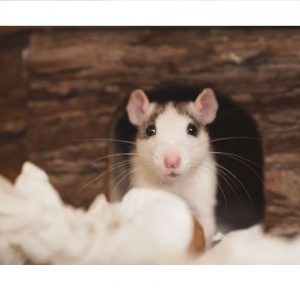Rats are one of the most resilient animals on earth. They survived mass extinctions, ice ages, atomic bombs, and the modern world’s ever-changing climate.
Owing to their relatively small size and flexible bone structure, they can squeeze through some surprisingly tight spaces where they hide and reproduce prolifically.
When thinking of getting a pet rat, you might question yourself, how big can a rat get? An average adult rat can grow up to 20 inches long from nose tip to tail tip.
But did you know some rats can grow up to 35 inches long and weigh up to 3 pounds? That’s about the size of a cat!
How Big Can An Average Pet Rat Get?
A newborn rat is about 1 ½ inch from nose to rump and weighs 4 to 8 grams. Males are called bucks and are often larger than females also known as does.
An average adult rat can grow up to 20 inches long from nose tip to tail tip. The average body weight is between 225 and 500 grams.
But let’s see pet rat sizes in more detail!
Pet Rat Size Guide
This chart compares the sizes of common pet rats and other giant rodents:
| RAT/RODENT | LENGTH (head to tail) | WEIGHT | HABITAT |
| Norway Rat | 16 to 20 in | 200 to 500 g | anywhere |
| Dumbo Rat | 15 to 22 in | 400 to 700 g | human habitats |
| Black Rat | 11 to 16 in | 150 to 280 g | anywhere |
| Pack Rat | 12 to 18 in | 300 to 600 g | arid or semi-arid land |
| Kangaroo Rat | 9 to 12 in | 70 to 170 g | desert flatlands, sandy soils, creosote flats |
| Swamp Rat | 7 to 16 in | 115 to 120 g | dense vegetation in swamps and watercourses |
| Bandicoot Rat | 15 to 26 in | 500 to 1000 g | steppes, forests, deserts |
| Bosavi Wooly Rat | 32 in | 1500 g | mountain rainforest |
| African Giant Pouched Rat | 24 to 35 in | 1000 to 1500 kg | forests, woodlands, farmlands, rural areas |
Over 60 species of typical rats belong to the genus Rattus. Only those belonging to this group are considered “true rats.” The two most common species are brown rats also called Norway rats and black rats also called roof rats or ship rats.
Unlike cats and dogs, there are no rat breeds. Pet cats come in different varieties in terms of coat colors, coat types, ear types, and markings. “Fancy” is a term used to refer to all domesticated rats, which are bred as companion pets or as show animals.
Most fancy rats are descendants of wild Norway rats. They have a very enthusiastic following because of their friendly and curious nature.
Dumbo rat is a popular fancy rat variety with large ears on the sides of the head instead of on the top, similar to that of the beloved Disney character, Dumbo the elephant.
How Big Is The Biggest Rat In The World?
The world’s largest rat is the African giant pouched rat, which also goes by the name Gambian pouched rat. Some rat-like rodents are called rats even though they are not true rats.
This African native measures up to 35 inches from head to tail with an average weight of 3 pounds. The largest known species weigh up to 9 pounds.
You can distinguish this rat from other rodents by its almost hairless, white-tipped tail. Similar to hamsters, pouched rats have large cheek pouches, which they use to gather food back to their hiding places.
But there are quite larger rodents (not rats) in the world. Here’s a list with images of the largest pet rodents you can get!
Are Pet Rats Bigger Than Wild Rats?
Pet rats tend to be larger than their wild counterparts. While they have the same body structures, their diet and activity are different.

Fancy rats are constantly fed by humans. Unlike wild rats, they do not have to scour their environment for food so they are not exposed to predators.
Pet rats can live for an average of 2 to 3 years, with a maximum reported lifespan of 4 ½ years. Wild rats, on the other hand, can only live for 1 to 2 years.
Because wild rats have shorter lifespans, they rarely reach their maximum size.
But remember that rats are opportunistic omnivores, which means they can survive on almost anything. As long as they have abundant food and a safe place to stay, it is possible for wild rats to grow bigger than pet rats.
In highly populated cities, a significant amount of food ends up in trash cans and dumpsters, offering endless buffets to the city rats. Exterminators have seen rats so big they could scare a cat away.
Pet Rat Growth Stages
Pregnancy in rodents is relatively short. It is approximately 20–23 days in rats and mice. There are five main stages in the life cycle of rats. Each stage has different requirements to maintain optimal growth and survival:
Nursing
Rat babies are born blind, deaf, and completely dependent on their mother’s milk. Their bright pink, thin, and translucent bodies are about 4 to 8 grams in weight and measure 1 to 3 inches.
Rat babies are usually called kittens or pups. They are born with baby teeth and whiskers, but their skin does not have fur or pigment yet.
When they’re born you really don’t need to go through much care with them, except check on the babies and their mother, to be sure they’re being cared for and the mother is healthy.
It’s important for the mother to have enough food and water since she’ll need those to keep strong and be able to properly feed her babies.
Weaning
By around 2–4 weeks, the pups are introduced to solid food. This stage typically lasts 4–5 weeks, or longer if the pup is allowed to stay with the mother.
The optimal weaning age is 21 days or 3 weeks after birth.
They weigh about 60 grams at this time and need high-protein food with lots of vitamins and minerals to initiate the pubertal growth spurt.
If this is your first time caring for baby pet rats, it’s good to contact your vet so you better know what supplements to give them. This way, you’re sure your new pet rats will grow healthy and strong!
Rats are social creatures so growing up with their littermates is important in developing complex social skills. At about 5–6 weeks, the babies are ready to leave mom and go to a new cage.
Adolescence
During sexual maturation, around 5–8 weeks from birth, females, and males should be kept in separate cages to prevent any pregnancies.
If a litter has only one pup of a particular sex, pet owners must make arrangements to house this rat with others of the same sex.
From adolescence to young adulthood, a rat can weigh between 115 to 300 grams.
Another option is to have your pet rats neutered. This way, you can have both male and female rats living in the same cage.
It’s also good to know that neutering your pet rats will reduce the chances of tumors. So, if you’re not planning on breeding pet rats, it could be a solution for you and your pet rats!
Adulthood
Adult rats are between 16 and 20 inches in length and weigh between 250 and 500 grams.
Their weight depends on where they live or what they eat. Their personalities are pretty well-established at this time. Rats are considered adults at 2 months of age.
Since pet rats can and will eat anything you give them, it’s important to be selective with their food and give them the proper quantities.
Rats can very easily become overweight if we’re not careful and if they do not have enough physical activity.
It’s good to give your pet rats enough toys and accessories so they can entertain themselves and keep an active lifestyle! (link novo toys)
Old Age
Old age in rats occurs in 18–20 months; 18 months is equivalent to roughly 45 years in human age.
Menopause in female rats occurs between 15 and 20 months.
As mentioned before, overfeeding can lead to obesity and diabetes which significantly decreases a pet rat’s life span. It’s very important to feed your rat a balanced diet and avoid unhealthy, high-calorie foods.
If you’re unsure about how much food to give your pet rat, we have the perfect guide for you, so be sure to check it out! (link novo food)
Factors Affecting Pet Rat Size
Gender
Male adult rats are usually bigger than females because of the difference in growth patterns from puberty onwards.
Males can weigh up to 500 grams and females up to 300 grams. Males that were neutered at birth grow smaller and lighter than males neutered at weaning age.
This highlights the importance of a newborn rat’s testicles in regulating body growth in male rats.
It’s also worth mentioning that neutered pet rats will be less energetic. Male rats will also become less dominant, meaning you won’t see them fighting as much!
Nutrition
An adult rat needs 15 to 20 grams of food per day. A balanced diet consists of 12–18% protein (from vegetable or meat sources) and 5% fat.
This is part of a healthy pet rat diet (which we cover in detail in this guide here).

It’s tempting to overfeed your pets with treats and other unhealthy food. However, eating too many sweets or calorie-dense food can cause serious health problems among pet rats.
If your pet is not pregnant or lactating, they don’t need all that calories. Chunky rats are cute! But make sure to keep your rat at a healthy weight so they’ll live longer.
As a rule of thumb, we like to give our girls a special treat, like fruit and other veggies, once a week and extra special treats, like oats or even yogurt treats, once a month!
Activity
Obesity is a serious condition that can occur in low-activity rats. What makes us fat can also make our rats fat.
Always weigh your pet at least once a month to check for unusual weight fluctuations. Unlike most of us, rats are very active and generally enjoy exercise.
Give them an exercise wheel or better yet, be sure to feel their cage with plenty of toys and accessories to keep them happy and fit.
It’s also good to let them out of their cage once in a while, for some extra exercise so they don’t get bored of their surroundings.
I like to recommend having a safe pet rat perimeter, by using a pet playpen. This way, you can set up mazes, digging boxes, and other puzzles for your pet rat to play with.
You can even join in the fun, by teaching them tricks (here are some of the best)! They’ll certainly enjoy these bonding moments with you.
Species
Most pet rats are of medium size but some species can grow bigger than others.
Various species of giant rats can be found in Africa, Asia, New Guinea, and South America. The largest rodent in the world is Capybara.
The largest true rat is the Bosavi wooly rat but is yet to have an official classification.
FAQs
Why do some rats get so big?
There are many factors that can affect the size of a rat. It depends on their genes and their access to food. Rats that live longer and eat a variety of food are usually bigger than those with a specialized diet or don’t have varied food sources.
Can rats get as big as cats?
The Bosavi wooly rat is a new species discovered in the crater of an extinct volcano in 2009. This giant rat is said to be as big as a cat. However, pet rats, even the obese ones, are unlikely to reach the same size.
What rodent is bigger than a rat?
The largest rodent called the Capybara is native to South America. They belong to the family Caviidae, which also includes the wild cavies and guinea pigs. An adult capybara has an average weight of 35 to 66 kg.
If you’d like to see the entire list of the biggest pet rodents (with images) click here!





